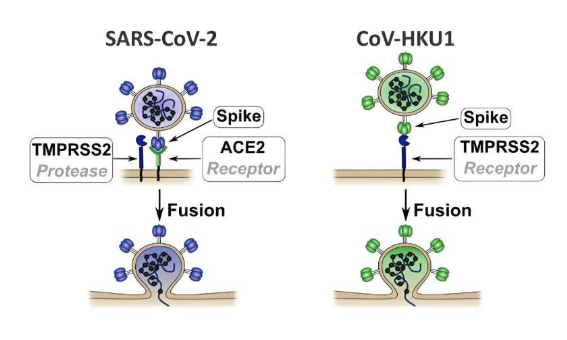-
Telephone:400-882-7987
-
wechat:15523376158wechat:15950040099

CauseCOVID-19The SARS-CoV-2 virus can cause severe acute respiratory disease.SyndromesThis may be in contrast to other coronaviruses known to cause mild seasonal colds in 2019, and raises the question of why one coronavirus has a more serious ict on humans than another. Recently, an article was published in an international journal.NatureIn the previous research report entitled "TMPRSS2 is a functional receptor for human coronavirus HKU1"Scientists from institutions such as the Pasteur Institute have provided part of the answer and identified the pathway through which the seasonal coronavirus HKU1 enters human cells.
The receptor bound by HKU1 is different from that of SARS-CoV-2, which may partly explain the difference in severity between the two coronaviruses. Receptor energy can be used as a useful method to clarify the transmission and pathological characteristics of coronavirus, which can be used as part of virus evolution monitoring. At present, there are seven known coronaviruses that can infect humans, of which four are generally considered to be mild pathogenicity, including HKU1, 229E, NL63 and OC43, and the other three have strong pathogenicity, including SARS-CoV-1, Mers-CoV and SARS-CoV-2. As early as 2005, researchers first isolated HKU1 from an elderly person from Hong Kong with severe pneumonia. Like SARS-CoV-2, HKU1 mainly infects the upper respiratory tract cells of the body. However, it rarely infects the bronchi and alveoli of the lungs. HKU1 virus can cause colds and other mild respiratory symptoms. At the same time, patients may have complications, including severeRespiratory tract infection, especially in young children, the elderly andImmunityIt is estimated that 70 per cent of children in dysfunctional individuals will be infected before the age of 6, and 75 per cent of the world's population has been exposed to HKU1, perhaps on a par with other seasonal human coronaviruses.

Scientists have identified the special receptors used by coronaviruses to enter human cells.
Source of picture:Nature (2023). DOI:10.1038/s41586-023-06761-7
At the cellular level, the spike protein of coronavirus will be cut or split in half when it binds to the receptor. This division is very important for the fusion, entry and proliferation of coronavirus. Some coronaviruses (such as SARS-CoV-2 and NL63) can use ACE2 receptors as the gateway to cells. So far, HKU1 and OC43 are the only coronaviruses with unknown receptors. In this study, the researchers identified TMPRSS2 enzymes as receptors that can enter the cells as HKU1. Once the binding occurs, TMPRSS2 will induce the fusion of HKU1 and cells, resulting in virus infection. By using a variety of technical combinations to test in vitro and in cell culture, the researchers found that TMPRSS2 receptors have a high affinity with HKU1 spikes, while this is not the case with SARS-CoV-2.
Researcher Olivier Schwartz said that once the receptor of the virus is identified, it is possible for us to more accurately characterize the target cells and to better understand the mechanism of virus entry, proliferation and pathophysiology of infection. This study also reveals a variety of evolutionary strategies adopted by coronaviruses, which can use TMPRSS2 to bind to target cells or induce fusion between virus and target cells, as well as virus entry. These human pathogenic viruses can use different receptors to affect the severity of the disease, and the levels of receptors are also different in respiratory tract cells, thus affecting the sensitivity of cells to infection and virus transmission. Once they know how the virus enters the cell, researchers may be more effective in fighting infection by developing targeted therapies and assessing the virulence risk posed by any new coronaviruses in the future.
At the same time, researchers have also developed and revealed a nano-antibody that can inhibit HKU1 infection by binding to TMPRSS2 receptors, and these preparations have been patented for their potential therapeutic activity.In summary, the results of this study reveal a variety of evolutionary strategies of coronavirus, which may use TMPRSS2 to directly bind to targeted cells or guide spinous processes to carry out virus membrane fusion and enter targeted cells.(Biological valleyBioon.com)
Original source:
Saunders, N., Fernandez, I., Planchais, C.et al. TMPRSS2 is a functional receptor for human coronavirus HKU1. Nature (2023). doi:10.1038/s41586-023-06761-7

